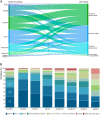Characterization of type-specific HPV prevalence in a population of persistent cutaneous warts in Flanders, Belgium
- PMID: 37840107
- PMCID: PMC10577142
- DOI: 10.1038/s41598-023-44154-y
Characterization of type-specific HPV prevalence in a population of persistent cutaneous warts in Flanders, Belgium
Abstract
Cutaneous warts are benign skin lesions caused by the human papillomavirus (HPV). Even though they are considered benign, they can have a considerable impact on the quality of life and cause serious illness in certain immunocompromised populations. Studies have shown that the efficacy of wart treatment is dependent on the causative HPV type. Therefore, in this article, we aim to determine the HPV genotype-specific prevalence in cutaneous warts of a Flemish population as part of the Omnivirol-Salycilic acid randomized controlled trial. Swab samples of cutaneous warts (n = 269) were collected during enrollment. The DNA extraction was performed on the automated NucliSENS® easyMAG® system (bioMérieux). The samples were analyzed with two separate in-house PCR assays capable of detecting the most prevalent cutaneous HPV types (i.e. wart-associated HPV qPCR) as well as the most relevant mucosal types (i.e. RIATOL qPCR assay). In total, the type-specific prevalence of 30 distinct HPV genotypes was determined. The beta-globin gene was used as a cellularity control and for viral load quantification. Data concerning wart persistence, previous treatment, wart type, and other relevant wart and patient characteristics was collected through a baseline questionnaire. The study population consisted mostly of persistent warts considering that 98% (n = 263) of the sampled skin lesions were older than six months and 92% (n = 247) had undergone previous treatment. The most prominent wart type was the mosaic verruca plantaris (42%, n = 113). The most prevalent HPV types were cutaneous HPV types 27 (73%, n = 195), 57 (63%, n = 169), and 2 (42%, n = 113). Only 2% (n = 6) of the lesions was HPV negative. The highest median viral loads were observed with HPV27 and 57 (i.e. 6.29E+04 and 7.47E+01 viral copies per cell respectively). The multivariate analysis found significant associations between wart persistence and certain wart types, the number of warts, and HPV genotypes. Based on these findings, persistent warts are more likely to: (1) be verruca vulgaris, verruca plantaris simple or mosaic, (2) to manifest as multiple warts, (3) and to be negative for HPV type 2 or 4. These characteristics can be useful in the clinical setting for future risk stratification when considering treatment triage and management. Trial registration: NCT05862441, 17/05/2023 (retrospectively registered).
© 2023. Springer Nature Limited.
Conflict of interest statement
The authors declare no competing interests.
Figures



Similar articles
-
Development and validation of a wart-associated human papilloma virus genotyping assay for detection of HPV in cutaneous warts.J Med Virol. 2021 Jun;93(6):3841-3848. doi: 10.1002/jmv.26623. Epub 2021 Mar 1. J Med Virol. 2021. PMID: 33090508
-
A non-invasive method for diagnosing plantar warts caused by human papillomavirus (HPV).J Med Virol. 2022 Jun;94(6):2897-2901. doi: 10.1002/jmv.27514. Epub 2021 Dec 15. J Med Virol. 2022. PMID: 34890486
-
Lesional HPV types of cutaneous warts can be reliably identified by surface swabs.J Clin Virol. 2011 Oct;52(2):84-7. doi: 10.1016/j.jcv.2011.06.016. Epub 2011 Jul 27. J Clin Virol. 2011. PMID: 21798797
-
Paediatric Cutaneous Warts and Verrucae: An Update.Int J Environ Res Public Health. 2022 Dec 7;19(24):16400. doi: 10.3390/ijerph192416400. Int J Environ Res Public Health. 2022. PMID: 36554279 Free PMC article. Review.
-
Different skin wart types, different human papillomavirus types? A narrative review.Acta Dermatovenerol Alp Pannonica Adriat. 2023 Dec;32(4):165-171. Acta Dermatovenerol Alp Pannonica Adriat. 2023. PMID: 38126099 Review.
Cited by
-
Development of human papillomavirus and its detection methods (Review).Exp Ther Med. 2024 Jul 31;28(4):382. doi: 10.3892/etm.2024.12671. eCollection 2024 Oct. Exp Ther Med. 2024. PMID: 39161614 Free PMC article. Review.
-
Effective Treatment of Cornu Cutaneum With Pachaieruvai: A Traditional Siddha Medicine.Cureus. 2025 Mar 28;17(3):e81326. doi: 10.7759/cureus.81326. eCollection 2025 Mar. Cureus. 2025. PMID: 40291255 Free PMC article.
-
Atypical HPV Typing: Detection of Genital-Associated HPV Type 6 in Verruca Vulgaris of the Hands and Feet in an HIV-Positive Patient.Int Med Case Rep J. 2025 Jan 11;18:67-74. doi: 10.2147/IMCRJ.S494454. eCollection 2025. Int Med Case Rep J. 2025. PMID: 39817050 Free PMC article.
References
-
- Sterling JC, Gibbs S, Haque HSS, Mohd MMF, Handfield-Jones SE. British Association of Dermatologists’ guidelines for the management of cutaneous warts 2014. Br. J. Dermatol. 2014;171:696–712. - PubMed
-
- Cardoso JC, Calonje E. Cutaneous manifestations of human papillomaviruses: A review. Acta Dermatovenerol Alp Pannonica Adriat. 2011;20:145–154. - PubMed
Publication types
MeSH terms
Substances
Supplementary concepts
Associated data
LinkOut - more resources
Full Text Sources
Medical

